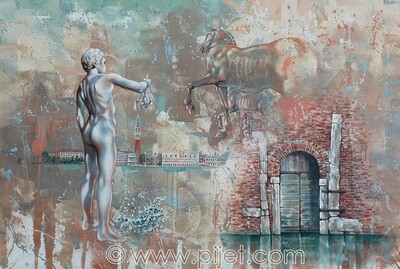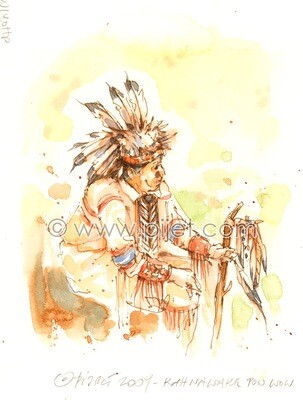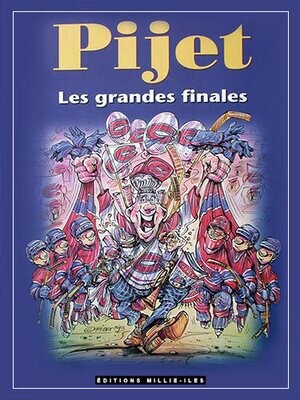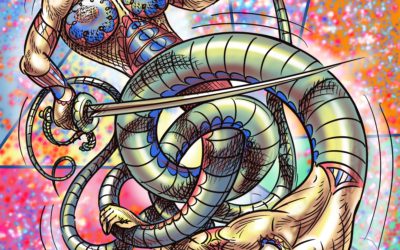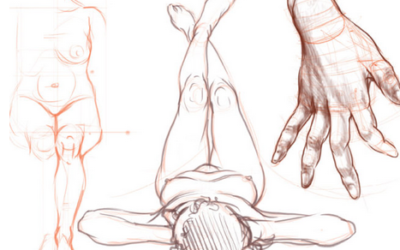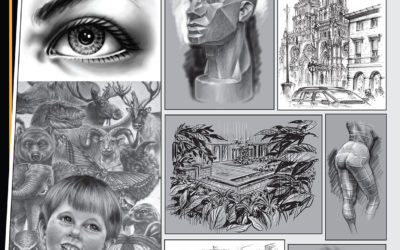“Van Dongen: A Fauve in the City.”
The reputation of Paris as a leading center of important economic, socio-political and cultural changes was already well established in European social circles at the beginning of the twentieth century. The booming industrialization inspired various economic activities in every aspects of human existence. The market for the commodities of all kind was constantly growing and opening widely for business offerings basically everything, including indecent services, as long as the buyer was able to afford its price. The city of Paris was becoming the international center of the world of fashion, entertainment, and Modern art. Despite its administrative problems related to the overwhelming population growth not followed by the infrastructural necessities in order to accommodate the new arrivals, Paris embraced everyone who was looking for a chance of a working space in the city. The artists from around the world were crossing each other on the streets of Paris, pursuing their dreams for a success and recognition of their talent. Kees Van Dongen,[1] whose exposition was hosted by the Museum of Fine Arts in Montreal, was one of many who tried to establish his artistic personality in Paris, and one of few who was able to do it successfully during his lifetime.
The Van Dongen’s exposition in Montreal gathered artworks from different periods of his artistic carrier. The artworks which capture a particular attention are the drawings titled: “Woman Drinking Absinthe” (see fig.1), “Cocotte” (see fig.2), and “Le Mepris” (see fig.3). These particular artworks Van Dongen executed during the time he was working for the Parisian reviews such as La Review Blanche, L’Assiette au Beure, Le Rire, and Gil Blas. The magnetic power of these artworks attracts the viewer not only for its aesthetics, but also because of their refine commentary and psychological content. These drawings were executed between the years of 1901 and 1902. These three artworks belong to the series of drawings[2] created by Van Dongen during his first years in Paris.[3] It was the time when he had to struggle for surviving by drawing portraits of people in cafeterias and on the streets in order to be able to sustain him-self and his young family. Van Dongen’s sharpness of his allegoric statements is emanating from these artworks at the viewer with horrifying exposure of the psychological summary of French classes. These drawings depict the social degradation of Parisian society. The picture “Woman Drinking Absinthe” differs from all the others exposed in the museum. In this artwork Van Dongen made editorial comment taking as a subject the problem of prostitution in Paris. At first regard the artwork gives an impression of humoristic view on the male versus female relations. However, this particular drawing Van Dongen executed not in the conventional realistic way as he did with the other drawings. This time the semiotic ambiguity of his judgment of the social degradation is enforced by psychological allegory to the human basic instincts. He exposes the animal nature of human beings. It is a dark satire on the imperfection of the phallic social system. Besides the editorial subjectivity the artwork does not have yet the “Van Dongian” fauvist flavor. Instead, the aesthetics and technical particularities of the drawing ”Woman Drinking Absinthe” suggest enormous influences of Toulouse-Lautrec’s artistic style. Especially in these particular artworks the freedom of the brush is definitely borrowed either from Toulouse-Lautrec, Edgar Degas, Pierre Bonnard, or from all of them at the same time.[4]
Submitting the artwork to the closer examination of its symbolic allegorical meaning, it is necessary to begin with the general description of its content. Van Dongen depicted a seating woman on the street in black dress with her legs covered with black stockings spread widely in a provocatively inviting position in the direction of the metamorphic skeleton of either a rabbit, or a dog, with a human skull and a tuxedo hat on it. The seated position of the skeleton suggests a rabbit, which symbolizes besides many other meanings the dishonesty, damaging activities, as well as a man’s libido. We can also consider that it is a hesitating dog that is not sure if the tempting garter in the hand of the woman is worth the bite. In such case, the dog symbolizes greediness and bad habits. Both descriptions fit the image well. The woman, according to the title of the drawing, is drunk what would symbolize her weakness and frivolity. Her head is covered with the hat with an evident unspecified red decoration on it. Her lips are in red and the visible underwear between her legs is red too. The red color goes from her head through her lips to the woman’s underwear. It is symbolic reference to the three steps of merchandising the prostitute services. The first is the idea of selling her body for money. The second is her mouth, through which she would trade with the client. The third would be the final consumption of the purchased “ goods.” The Woman is supporting her seating figure with her right hand preventing herself from falling. With her left hand stretched out, she is grasping her garter. She is trying to attract the metamorphic creature between her legs. The skull of the creature has an opened mouth, what emphasizes his hunger and the desire to bite the garter, or more. The spread legs are actually preventing the metamorphic creature from escaping, exposing the red flounces as an additional element of temptation. The drawing is executed with great artistic freedom of the brush and mixed media.[5] The image provocative composition is catching the viewer in its psychoanalytic imaginary spider net. From the psychological point of view the image itself does to the viewer exactly what the woman does to the metamorphic creature. It emanates the temptation. It attracts the viewer’s attention by its unusual allegoric symbolism. It is Van Dongen’s the only artwork at the exposition with the surrealistic taste. The allegory of this image is evident and represents the essence of Parisian realities viewed through the critical perception of the artist’s intellect. Van Dongen’s irony in this drawing reflects the consequences of industrialization and its impact on the style of living of those less fortunate who became as merchandise for those who can afford it. The prostitution in Paris become affordable commodity and followed closely the development of consumer society. The difference in the sizes between the woman and the metamorphic creature figures symbolizes how serious the problems of social inequities were at that time, and how devastating the prostitution was as means of gaining a leaving, especially for women.[6] The overwhelming figure of the lady refers to the demography of poverty among the lower classes of Parisian society, which was ruled by the financial power of the bourgeoisie and the capitalist exploratory system, which on the image is represented allegorically as the metamorphic creature. The artwork represents in itself a sort of diagram of economic divisions between the poor and the rich classes in Parisian society at the beginning of the twentieth century. The skeleton beast refers to the phallic demoralizing attitude towards the lower classes. It reflects the elaborated taste of the bourgeoisie to the commodities available to them through their monetary power. The seating woman represents allegorically the social devaluation of human dignity to the object of commodity. Van Dongen, during the time of working on the editorial illustrations for the magazines, produced great deal of drawings. Each of them was accompanied with intelligent commentaries spicy to the point, but in the drawing “Woman Drinking Absinthe,” he proved his great talent of critical psychoanalytic artistic judgment and elaborated perversity of intellectual thought.
Taking in consideration Van Dongen’s Parisian realities at the beginning of his carrier, the interpretation of Van Dongen’s drawing “Woman Drinking Absinthe,” would be quite different. Analyzing his artwork without any knowledge of any specific details about his personal life, the viewer would come to less or more the same interpretation of his drawing as it was explained earlier in this paper. However, knowing about the hardship of his life at the beginning of his Parisian period, as well as his brilliant carrier, which started few years later, this artwork represents the artist himself and his Parisian realities. The drawing “Woman Drinking Absinthe” illustrates an unconscious prediction of Van Dongen’s own future. Van Dongen in his own words stated in his biography: “I am a prostitute of my glory.”[7] Van Dongen’s well being depended on the bourgeoisie interest in his art. In such case the reading of the artwork “Woman Drinking Absinthe” would be different. The female character would represent Van Dongenès affords to attract attention to his talent and his artistic services. The meaning of the metamorphic character would not change. The creature would still represent an important monetary aspect, but in different sense. This time it would be the bourgeoisie’s taste for Van Dongen’s art. The artist in this artwork exteriorized his own artistic struggles. He referred himself as a prostitute, because from the beginning he had to put aside painting and concentrate on publishing in order to survive. The ambiguity of this drawing could refer to Plato’s “problem” with the art, when he said that the artists speak through the images more than through the ideas, what makes the truth cloudy and so not clear.
The artwork “Cocotte” follows similar psychological pattern of the ridicule aspects of live imposed on women in Patriarchal social order. The naked body of sleeping woman is lying on a bed. The body has a signs of physical fatigue related to the erotic services and her supposedly advanced age. The vapor coming from the oil lamp forms a word “Cocotte”[8] floating over her head. In the darkness of the room behind the bed a face of a man is slightly visible. His face expresses his madness of desire for sexual pleasures seemingly available just in front of him. He may represent also “Death” waiting for the body to “burn out” like the oil lamp, so it can take it to the abyss of the “Hades.”[9] In the right corner the way the vapor is turning gives an impression of another individual standing behind the woman’s bed. Assuming that it may be the case, the artist refers to the biblical story of “Susanna and the Elders.”[10] It fits perfectly to the story drawn by the artist. In either way in this simple drawing Van Dongen depicts sarcastically the essence of the human existence.
The drawing “Le Mepris” refers to the common social phenomenon during the times called the “Belle Epoch” when the rich bourgeois men used to take advantage of young women coming to Paris with a hope to find better working conditions and socio-economic opportunities. Instead, they fell in the hands of rich bourgeois men who, with promises of eternal love and possibilities of marriage, misled the women’s cautious attitude. Those women who were unlucky enough to meet such individuals on the streets of Paris, were placed in rented apartments paid by the men and in exchange for the promised dream of marriage, they served to those men for entertainment of sexual pleasures. Many of the men had their own families and regardless to this fact their financial fortune inspired them to have indecent ideas. This euphoria of happiness lasted untill the woman got pregnant. Then usually women were left alone with the babies and without any possibilities of financial support from the child’s father. Most of the times they were thrown out from the apartments they were occupying when they were still unspoiled by the pregnancy. Many women suicides, others went back to their homes in the country, and yet some of them were lucky to survive in the city. Such situations were common in Paris, and Van Dongen as a good observer commented these situations with the brush of his own intelligent sarcasm. In the drawing “Le Mepris” Van Dongen draws a woman sitting in the room on a chair with her back towards the window and her face covered with her hands. Her posture suggests that she is worried and crying. Her face is not visible but it is evident that she is unhappy. The large curtain separates her from the window, which symbolizes the exterior world. The balustrade ornament, which is visible in the lower part of the window’s exterior, suggests the possibility of pleasant and fancy life. The fact of her pregnancy separates her from the exterior world and the enjoyment of life, which she was experiencing before. From now on what she has left is the darkness in front of her marked by the artist with the dark color brush strokes. The picture is accompanied by the captions: “Lover went away… woman is left alone… with her baby.” The text completes the moral of this story. This artwork represents yet another simplicity and depth of Van Dungeon’s thought and his brilliant mind. Studying these drawings makes it evident Van Dongen’s exceptional sense of social critic and proves his intellectual draftsmanship. These three chosen works represent a particular period in Van Dongen’s artistic quest. It was the time when he needed badly to work and earn enough money to make his living. Van Dongen with his extraordinary commentary intuition did not have any problem to make a great satire on any subject.
Analyzing Van Dongen’s artwork from the formal point of view his line and color from the time of his editorial production did not represented yet its future characteristics. During that time Van Dongen did a significant amount of drawings as those discussed earlier in this essay. Their main characteristic was the economy of line and color what certainly was dictated by the technological means available at that time. However, what strikes the most in these artworks is their similarity to the lines of drawing of another artists as Toulouse-Lautrec for example. It is obvious that artists always get inspired one another and with the solid and constant dynamic practice with the passing time they develop their own visual distinguishable characteristics. In Van Dongen’s case it is very clear that his early paintings and drawings have eclectic characteristics. Looking at his artwork from his early period it is evident to see all his favor artists such as Frans Hals, Goya, Manet, and Toulouse-Lautrec collected together. He was amalgamating different styles, which seems typical for most of young artists. Focusing on the drawing “Woman Drinking Absinthe” one thing seems evident that he borrowed the brush stroke from Henri Toulouse-Lautrec. Van Dongen mentioned that he saw the artist from time to time on the streets of Montmartre passing by him when he was drawing caricatures and portraits of people on the street [11]during his first staying in Paris. He did not speak to Toulouse-Lautrec because of shame of being too poor and unpleasantly looking. The fact that Van Dongen mentioned such incident proves that he knew of the artist’s artwork at that time. Comparing the drawing “Woman Drinking Absinthe” with some of Toulouse-Lautrec’s artworks (see fig. 4, 5, 6, 7, 8 ) proves the point of enormous resemblances. It to put together the Van Dongen’s drawing “Woman Drinking Absinthe” and chosen samples of Toulouse-Lautrec’s drawings, it would seems like it is Toulouse-Lautrec’s artwork. The way Van Dongen is applying the paint on his work has the same characteristic tonality. The nervousness and spontaneity of the lines are identical to Toulouse-Lautrec artworks “Monsieur, Madame and her Lapdog” (see fig. 4) and “Alone” (see fig. 5). It is particularly visible in the Toulouse-Lautrec’s “Alone” drawing. The Van Dongen’s and Toulouse-Lautrec’s drawings share the same energy of brush strokes and can actually be part of the same series. Another interesting resemblance is visible when looking at the faces on Toulouse-Lautrec’s drawings such as” Alone,” “Woman Pulling up her Stockings,” (see fig. 7) and “The Tattooed Woman or The Toilette:” the face of the woman on the first artwork and the two faces of the women helpers depicted on the two other drawings are almost the same to the face of the woman depicted on Van Dongen’s artwork. Their physical profiles and the expressions are identical. What is also comparable between the Van Dongen’s and Toulouse-Lautrec’s drawings in this particular case is the way Van Dongen treats chromatically the background of his work. The verticality of brush strokes is identical. Especially when comparing the Van Dongen’s artwork with the drawings “The Brothel Laundryman,” “Woman Pulling up her Stockings,” and “The Tattooed Woman or The Toilette.” The Van Dongen’s artwork “Woman Drinking Absinthe” is quiet different form all the other drawings exposed from the first period of his artistic struggles in Paris. The second sample of Van Dongen’s artwork “Cocotte” looks almost an allegorical copy of Toulouse-Lautrec’s drawing “Alone.” The two women share the same laying body position. The two other artworks “Cocotte” and “Le Mepris” besides their graphic resemblances with Toulouse-Lautrec’s brush line have similarities to the two other artists such as Edgar Degas and Pierre Bonnard.
Comparing Van Dongen’s “Cocotte” and Le Mepris” with Degas’s artworks of the ballet dancers (see fig. 10, 11, 12) the strong decisive lines of the Van Dongen’s figures resemble the heavy outlines on the Degas’s drawings. In Degas’s “Dancer” the hairs of the woman is depicted with the same perfect economy of color like on the Van Dongen’s “Le Mepris.” The solid well granted lines drawn by Degas with the charcoal are visible in Van Dongen’s treatment of his figure of the woman in the drawing “Le Mepris.” Van Dongen’s brush follows the Degas’s pattern. The same concerns the Degas’s depiction of the dancers dresses on his artworks. Van Dongen applied his technique on the curtain, floor, and on the garment of his character. The Degas’s famous painting “Dans un café: L’Absinthe” (see fig. 13) also inspired Van Dongen in creation of his drawing discussed previously “Woman Drinking Absinthe.” He borrowed the subject from Degas’s painting and created his own interpretation of it. Some elements from Degas’s painting such as a sitting woman’s with slightly spread legs, red gather skirt, and boots are the same as in Van Dongen’s drawing. However, Van Dongen recomposed the entire situation; in Degas’s artwork the indifferent man is sitting beside the lady; in Van Dongen’s drawing he is in front of her hesitating and to some point indifferent to her charms as it is visible on Degas’s work. It is perfect allegorical view of Dega’s masterpiece with Van Dongens’s spicy intelligence of a great cartoonist.
The Pierre Bonnard’s influence on Van Dongen’s artwork referring only to the chosen drawings is a visible freedom of his lines what gives sometimes an impression of sketch. The Bonnard’s freedom of line without any preoccupation about anatomic correctness and its slightly cartooning look are visible also in Van Dongen’s samples represented in this essay. Anatomically speaking all three samples of Van Dongen’s drawings has traces of Bonnard’s drawings (see fig. 14, 15, 16, 17). Bonnard’s liberty of line and characteristics of certain naivety and lightness of his drawings encourage Van Dongen to liberate his stoke from certain rigidity of Degase’s heavy outlines of his ballet models. Bonnard’s artwork has certain amount of psychological complexity. Van Dongen saw this nuances in Bonnard’s artworks.
Van Dongen through the psychological collages of his allegorical imagery he was inspired by the greatest artists of the Parisian bohemia and as many artist before and after him is trying to make a sense of the mysterious world of their creative minds.
Van Dongen’s chosen artworks exposes the psychological mirror of Parisian realities. He experienced it by leaving in doubtful neighborhoods at the beginning of his crusade for the fame and glory. The world where Van Dongen was searching for recognition was the world he criticized brilliantly in his early years, and portrayed it with a great success later. It was the world he depended on through all his life, as his female symbolic character in his drawing “Woman Drinking Absinthe.”
[1] Kees Van Dongen, Daitch painter, born in 1877 in Delfshaven, the Rotterdam’s suburbia’s. He arrived in Paris the first time in 1897, than the second time in 1900, a year of the opening of the first line of metro in the city. Van Dongen was the only faithful representative of Fauvism through almost all his life.
[2] Van Dongen was able to obtain the contracts for satirical illustrations for such French reviews as: La Revue Blanche, Le Rire, L’Assiette au Beurre, and after nineteenth and three the Gil Blas.
[3] Van Dongen first came to Paris in 1897 but had to leave because of financial difficulties. He returned again in 1900 and decided to stay. In 1901 he got married in Paris with Augusta Pretinger. He had one daughter with her.
Bibliography:
Crespelle, Jean-Paul. Les Fauves. Neuchâtel: Editions Ides et Calendes, 1962.
Dorival, Bernard. The School of Paris, in the Musée d’Art Moderne. London: Thames and Hudson, 1962.
Ferrier, Jean-Louis. Les Fauves, Le Règne de la Couleur. Paris: Éditions Pierre Terrail, 1992.
Hopmans, Anita. Van Dongen Retrouvé. Rotterdam: Anita Hopmans & Museum Boijmans Van Beuningen, 1996.
Kyriazi, Jean Melas. Van Dongen, et le Fauvisme. Lausanne-Paris: La Bibliotheque des Arts, 1971.
Kyriazi, Jean Melas. Van Dongen, Après le Fauvisme. Lausanne: Edita-Lazarus, 1987.
Leeman, Fred. “The Van Dongen Nobody Knows, Early and Fauvist Drawings, 1895-1912.” Exhibition Catalogue by Anita Hopmans. Master Drawings, Vol. 36, No. 3 (Autumn, 1998): 316-318.

